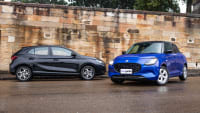Have you ever been cruising along the road, minding your own business, and wondered: Who is allowed to use T3 lane without restriction? No? Me either, but let’s crash-tackle this tricky subject anyway…
First up, there are a few other questions to answer, such as what is a T3 lane?
Transit lanes were created to encourage carpooling and, in so doing, the hope was that there’d be fewer cars on the road and thus road travel would be safer and a smoother flow of traffic would be ensured. That’s the theory, anyway.
The T3 lane (aka the transit lane; T3 = Transit 3 passengers) can be used by vehicles containing a certain number of people, three or more. So, who can use a T3 lane? Public buses and minibuses, taxis, hire cars with hire car number plates, motorcycles and bicycles.
Can emergency vehicles use T3 lanes? Yes, emergency, special-purpose and breakdown vehicles can use transit lanes, regardless of the number of people in their vehicles, according to the NSW state government. And that, my learned friend, also answers the question I knew you were about to ask: Who is allowed to use T3 lane without restriction?
But there are limitations of use for the rest of us normal folk.
In NSW a passenger car can only drive in a T3 lane during the times and days specified on the sign (e.g. 6am to 10am Mon to Fri) when there are three or more people in your vehicle, including the driver.
How far can you travel in a T3 lane? You can drive in the T3 lane as long as you have the requisite number of people onboard – three – and, no, Myer mannequins aren’t people.
Who is allowed to use a T3 lane? As well as those mentioned above, electric vehicles are also permitted to drive in transit lanes regardless of the number of occupants until 30 June 2025.
.jpg)
As for a T2 (Transit 2 passengers) lane, in NSW you can only drive in this lane during the times and days specified on the sign (e.g. 6am to 10am Mon to Fri) when there are two or more people in your vehicle, including the driver.
Another query you might have is: How far can you travel in a T3 lane if you need to overtake the vehicle turning right? We’re getting to that. If you have less than the required number of people in your vehicle, you can only enter a transit lane for a maximum of 100m to: enter or leave the road, overtake another vehicle turning right or making a U-turn, or enter a lane from the side of the road.
One of the few exceptions to the T3 lane rules is this: any vehicle can drive in a transit lane to avoid an obstruction, or if a sign says you can.
Laws may vary from state to state/territory, or not – for instance, in Queensland “a T3 transit lane means you must have three or more people in the vehicle to use the lane. Buses, taxis, limousines, bicycles, and motorcycles can travel in transit lanes with or without passengers.” A T2 transit lane means you must have two or more people in the vehicle to use the lane in the Sunshine State. Check with the relevant state/territory authority so you’re up to date with the law there.
Penalties for the misuse of a transit lane in NSW may include being slugged one demerit point and fined up to $362.
Where can you find out more information about T3 lane rules and restrictions? Check out the relevant government transport information pertaining to the state/territory in which you’re travelling.
Bus lanes are for buses but can also be used by taxis (but not rideshare vehicles), hire cars with hire car number plates, special purpose vehicles (operated by or under the direction of Transport for NSW) responding to an emergency, or bicycles and motorcycles.
So, how far can you drive in a bus lane? Are cars allowed in bus lanes? If you’re in one of the vehicles mentioned in the paragraph above, then go for your life. But if you’re not and you drive a vehicle in a bus lane for longer than 100m, a bus lane camera may record your vehicle’s details. If this occurs, the registered vehicle owner may receive a penalty notice – ouch, bus lane demerit points.
You must not stop in a bus lane. The only vehicles that can stop in a bus lane are buses at a bus stop, or taxis and chauffeur-driven hire cars picking up or dropping off passengers.
Other vehicles can drive in bus lanes to avoid an obstruction or if there’s a sign saying they can. They can also drive in a bus lane for a maximum of 100m to enter or leave the road, overtake another vehicle turning right or making a U-turn, enter a lane from the side of the road.
So, there you have it. All sorted out for you. Now go and behave yourself on our roads.





.jpg)
.jpg)
.jpg)



.jpg)

.jpg)

.jpg)


.jpg)



.jpg)


.jpg)
